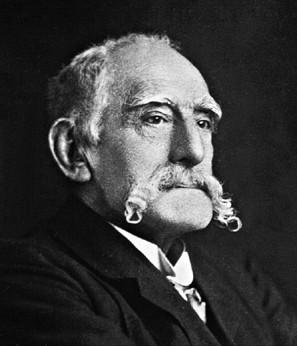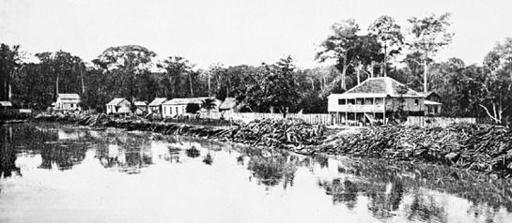1493: Uncovering the New World Columbus Created (45 page)
Read 1493: Uncovering the New World Columbus Created Online
Authors: Charles C. Mann
Tags: #Americas (North; Central; South; West Indies), #Expeditions & Discoveries, #United States, #Colonial Period (1600-1775), #History


Henry Wickham (
Photo credit 7.5
)
Rubber was Wickham’s exit from his failing manioc plantation in Brazil. Cannily eliciting Markham’s promise that the India Office would buy every rubber seed he sent, Wickham sought the help of his neighbors in collecting them. His plantation was located in Santarém, four hundred miles from the river’s mouth, a rubber town built atop a Jesuit mission built atop a native city. It was also the biggest center of ex-Confederates in the Amazon. With the aid of Confederate families, Wickham gathered seventy thousand seeds, enough to pay for passage back to Britain for himself and his wife. (He left behind, apparently without warning, his brother and his family, as well as his widowed brother-in-law.) To judge by the frigid reception he received in London, the India Office had not expected to be billed for three-quarters of a ton of rubber seeds. Nor were they overly happy that only 2,700 germinated—evidence, suggested the environmental historian Warren Dean, that Wickham and his associates scrambled through the forest in a hot-brained hurry, grabbing seeds from the ground without consideration for their viability.
Today Wickham is reviled in Brazil. Tourist guides refer to him as the “prince of thieves,” a pioneer of what has come to be called “bio-piracy”; the leading economic history of Amazonia denounces his actions as “hardly defensible in the light of international law.” At a literal level this claim is untrue; Brazil then had no bio-piracy laws. Nor is there any evidence that anyone tried to stop Wickham. The British were hardly secretive—London newspapers trumpeted Markham’s quest for rubber. And authorities in Santarém surely were aware that an English madman was packing up cases of rubber seeds. In any case Brazilians themselves have not hesitated to import exotic species. The nation’s primary agricultural exports today are soybeans, beef, sugar, and coffee. Not one is native to the Americas.
4
More important, the transport of useful species out of their home environments has been a boon to humankind. The quinine supply in the Andes was far too small for the world’s needs, even if collectors had hunted down every cinchona tree. Markham’s “bio-piracy” saved countless thousands in Asia and Africa from premature death. Transplanting the potato to Europe and the sweet potato to China created catastrophic social and environmental problems, as I have been at pains to argue. But it also kept millions of Europeans and Chinese from malnutrition and famine. The huge benefits of moving species outweigh the huge harms, though the balance can be closer than free-exchange advocates tend to admit. As Dean put it, “The transfer of seeds, even across national borders, even for the sake of crass profit, even in behalf of imperialism, may be counted as a foremost means of the aggrandizement of the human species.”
Two months after Wickham appeared in London, Kew shipped out the seedlings, most of them to Sri Lanka. Irritated with Wickham, the gardeners paid no attention to his recommendation that the trees be planted in open slopes away from marshes and riverbanks—the roots wouldn’t grow properly in soggy ground. Instead they planted the seedlings in forest wetlands. Even if the plants had flourished, Sri Lanka’s British colonists in 1876 were not interested in creating a new plantation industry. Two decades before, they had installed almost eight hundred square miles of coffee trees in the island’s hills and imported a quarter of a million Indians to tend them. A previously unknown fungus affected “two or three acres” of coffee in 1869. Three years later the director of the Sri Lanka botanical gardens was reporting that “not a single estate has quite escaped it.” Wickham’s seedlings arrived just as unhappy colonists were ripping out stricken coffee trees and planting tea bushes. (The coffee plague is sometimes claimed to be why the British hot beverage of choice is tea, rather than coffee.) Few were interested in replacing their new tea bushes with rubber. The same coffee disease struck Malaysia and Indonesia in the 1890s. Forced to restart there, planters tried the rubber trees that had been languishing in Sri Lanka. The fortunes quickly made in Malaysia—and Indonesia, a Dutch colony that also took some of Wickham’s trees—convinced Sri Lanka to take another look. Malaysia and Sri Lanka had a thousand acres of rubber plantations in 1897. Fifteen years later, the figure had grown to more than 650,000. For the first time more rubber came from Asia than the Americas. Prices fell, and the Brazilian rubber industry was reduced to dust.
Few in Manaus saw it coming—more evidence, if any were needed, of the human propensity to believe that flukes of good fortune will never come to an end. The city sank into lassitude, its opera house shuttered, its mansions abandoned. Rubber executives realized to their shock that laborers scattered across a forest the size of a continent could not produce latex nearly as efficiently as workers who moved down rows of closely packed trees. In their dismay few Amazonian businesses even tried to develop plantations. The first real chance the region had to recoup occurred in 1922, when British colonies in Asia, which had overplanted rubber, sought to control prices by forming a cartel. Among those enraged by this action were Harvey Firestone, the world’s biggest tire maker, and Henry Ford, the world’s biggest car maker. Firestone responded by creating a huge rubber plantation in Liberia. Ford planned one of equal size in the Amazon.
As a site he chose the Tapajós River, near Santarém, close to where Wickham had acquired his seeds. In an inauspicious debut for the project, Ford hired a Brazilian go-between who in 1927 sold him almost four thousand square miles of land up the Tapajós that happened to be owned by the go-between. To house his workers Ford built a replica of a middle-class Michigan town, complete with a hospital, schools, stores, movie theaters, Methodist churches, and wooden bungalows on tree-lined streets. On a hill was the Amazon basin’s only eighteen-hole golf course. Orderly and straitlaced as Ford himself, the town was the opposite of boomtown Manaus. Wags immediately dubbed the project Fordlândia. Because Fordlândia was hilly, removing the vegetation “caused massive erosion and drainage problems,” explained William I. Woods, a soil scientist and geographer at the University of Kansas. To prevent erosion, he told me, the company had to terrace the land, a “hideously expensive” process. In any case, Woods said, the soil was too sandy. Because the land was 135 miles up the Tapajós, oceangoing ships couldn’t dock there during the dry season. “Even if they got rubber, they couldn’t ship it out.”
For Ford, the next few years were a series of unhappy surprises. Only after the first season’s rubber trees died did the company find out that
H. brasiliensis
must be established at particular times of the year to thrive. Only after paying steamship bills did the company realize that it would not be possible to offset the cost of clearing all the hardwood trees on its land by selling the timber in the United States. And only after planting thousands of acres did the company learn that the Amazon has a fungus,
Microcyclus ulei,
that is partial to rubber trees. This last sentence is imprecise. The company did know that
M. ulei
existed. What it didn’t grasp was that there was no way to stop it.

At the peak of the rubber boom, Brazil sent engineer and writer Euclides da Cunha to survey its disputed western border. Lining the banks of the Purus River, an upper Amazon tributary, da Cunha found hundreds of rubber-processing facilities. (
Photo credit 7.5a
)
Click
here
to view a larger image.

To stoke the fires that boiled down the latex and to fuel the steamboats that took it downstream, each plant consumed huge quantities of wood—an early example of tropical forest destruction. (
Photo credit 7.6
)
Microcyclus ulei
causes South American leaf blight. Leaf blight begins when a spore lands on a
Hevea
leaf. Somewhat like the potato-blight spore, the minute, two-celled leaf blight spore grows a thin, rootlike tube that extends sideways, along the top of the leaf. Usually the tube is tipped by a structure called the appressorium. Executing a right-angle turn, the appressorium drills into the inner cells of the leaf. Depending on the leaf’s defenses, the details of the infection process vary. In any case the fungus almost always wins, penetrating the leaf. Inside it produces spores—many, many spores—which emerge from new tubes on the bottom of the leaf. They are knocked free by raindrops or brushed off by rubbing against other leaves. Left behind are ruined, blackened leaves, which fall off the tree. Leaf blight defoliates
H. brasiliensis.
The blighted trees I have seen, with their sparse black foliage, looked as if someone had gone after them with a blowtorch. Many trees survive a bout with
M. ulei,
but their growth is stunted; a second or third episode will kill them.
M. ulei
spores do not survive long after parting from their natal leaf. Thus
Hevea
trees in the wild are usually spaced widely apart; if one succumbs to leaf blight, the others are too distant to be attacked. In plantations, by contrast, trees are so close together that their upper branches are entangled. Spores hop from tree to tree like so many squirrels. Or the fungus can travel on the clothes and fingernails of plantation workers. That is what happened in Fordlândia.
Ironists will appreciate that
M. ulei
attacked just as Ford finally hired its first actual rubber expert, James R. Weir, a plant pathologist who was the ex-director of the U.S. National Fungus Collections. Weir’s first action for Ford was to travel to the Indonesian island of Sumatra, home to many rubber estates. Its rubber planters had found especially productive trees and learned how to propagate them by grafting wood from these trees onto sturdy rootstock. In thirty years they had created prodigious groves of high-yielding clones. Weir purchased 2,046 grafted buds in December 1933. Like the Brazilians who failed to block Wickham, the Sumatrans who didn’t stop Weir were upset about it later. Five months after his departure, Asian rubber producers formed a second, stronger cartel—and explicitly prohibited the removal of “leaves, flowers, seeds, buds, twigs, branches, roots or any living portion of the rubber plant.” By then Weir had carried his precious sprouts to Brazil, where they were about to be wiped out by
M. ulei.
M. ulei
exists in many different strains; if a fungicide wipes out one, the others move in. Weir launched an emergency testing program to look for resistant trees. Meanwhile he tried to establish a new, fungus-free plantation eighty miles away on better land that was closer to the mouth of the Tapajós. He filled it with the high-producing clones from Sumatra. The fungus overran the new plantation even faster than the old. By selecting their trees exclusively for latex yield, Asian farmers had inadvertently produced varieties with even less resistance to blight. The disaster effectively ended Fordlândia, though it wasn’t formally abandoned until 1945. Its fate made most Brazilians conclude that rubber plantations are not viable in the Amazon. When Ford bought land in Brazil, 92 percent of the world’s natural rubber came from Asia. Five years after Fordlândia ended the figure was 95 percent.
